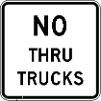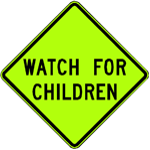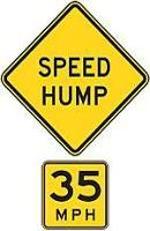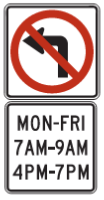Neighborhood Traffic Programs
VDOT offers various programs that neighborhoods, acting through their local governing bodies, may use to address certain traffic problems on their local streets. They include “Through Truck Restrictions”, “Watch for Children” signs, “Additional $200 Fine” signs, the “Traffic Calming” program and the “Residential Cut-Thru Traffic Program.”
 The Through Truck Restriction Program provides that a locality may request a restriction of through trucks on streets maintained by VDOT where such requests conform to the requirements and procedures in the “Guidelines for Considering Requests to Restrict Through Trucks on Primary and Secondary Highways” as prescribed by The Commonwealth Transportation Board (CTB).
The Through Truck Restriction Program provides that a locality may request a restriction of through trucks on streets maintained by VDOT where such requests conform to the requirements and procedures in the “Guidelines for Considering Requests to Restrict Through Trucks on Primary and Secondary Highways” as prescribed by The Commonwealth Transportation Board (CTB).
Restrictions proposed under this program apply to trucks (other than a pickup or panel truck) or truck-trailer combinations (including tractor-trailers) that are using streets as through routes where such streets cannot safely or adequately accommodate such truck traffic (e.g. due to narrow pavement widths, poor alignment or where the surrounding area is not compatible with such traffic such as in a residential area).
As prescribed in the CTB guidelines, the local governing body, after due notice and a proper public hearing, makes a formal request to VDOT according to the requirements stated in the guidelines. Requests that do not adhere to the requirements will be returned as stated in the guidelines. The guidelines also state that proposed restrictions not meeting the criteria in the guidelines will generally be rejected.
Where the request submittal, as well as the proposed restriction(s), meet the appropriate criteria in the CTB guidelines, further study will be conducted by VDOT and a decision to approve or deny the request made by VDOT or the CTB, as appropriate.
VDOT is mandated to act upon a request within nine months and incurs all installation and maintenance costs for posting signs for an approved restriction.
 The Watch for Children Sign Program provides a process for a county or town to purchase, install and maintain “Watch for Children” signs on their local streets that are maintained by VDOT. The signs alert motorists that children may be at play nearby. §33.2-251 provides that a county or town may enter into an agreement with the Commissioner of Highways (VDOT) to install and maintain these signs , and that “the cost of the signs and their installation shall be paid by the county or town.” Also, VDOT does not install these signs on its roads or on behalf of a county or town.
The Watch for Children Sign Program provides a process for a county or town to purchase, install and maintain “Watch for Children” signs on their local streets that are maintained by VDOT. The signs alert motorists that children may be at play nearby. §33.2-251 provides that a county or town may enter into an agreement with the Commissioner of Highways (VDOT) to install and maintain these signs , and that “the cost of the signs and their installation shall be paid by the county or town.” Also, VDOT does not install these signs on its roads or on behalf of a county or town.
To initiate the installation of signs, the representative of the town or county fills out the agreement included in VDOT’s guidance document and indicates the location(s) of signs to be installed. Signs may be installed on streets at the major entry points within a subdivision where the speed limit is 35 mph or less and where they do not conflict with other VDOT signs.
Secondary roadway construction or maintenance funds or any other VDOT monies may not be used by the locality to purchase, install or maintain these signs. The average cost to purchase and install a single such sign is $850.
VDOT’s “Guidance on the Installation of Watch For Children Signs lays out the complete process and requirements to be followed by the locality for requesting and installing these signs and the agreement document that should be used.
Upon VDOT’s authorization for the installation of signs on VDOT’s right-of-way, the locality may then install the requested signs.
 The Additional $200 Fine Signs Program provides for a county or town to install signs on certain residential streets maintained by VDOT indicating an additional $200 fine applies for speeding, in accordance with VDOT’s policy.
The Additional $200 Fine Signs Program provides for a county or town to install signs on certain residential streets maintained by VDOT indicating an additional $200 fine applies for speeding, in accordance with VDOT’s policy.
The policy describes the criteria and requirements that must be met for the installation of signs. Generally, the signs may be requested for a “Local Residential Street” as defined in the policy, where the posted speed limit is 45 mph or less and there is a documented speeding problem. Such residential streets are in a neighborhood or community where most of the residences face the street with driveway connections or curbside parking.
Upon a formal request by a county or town and supporting data as stipulated in the policy, VDOT staff will review the assembly and approve or deny the request as appropriate.
If approved by VDOT, the Locality fabricates and installs the signs as described in the policy upon appropriate permitting to complete such work on VDOT’s right-of-way. Signs may be funded by the locality or applicable VDOT funds where available or a combination.
 The Traffic Calming Program, as laid out in VDOT’s “Traffic Calming Guide for Neighborhood Streets”, provides communities with guidance and procedures to implement traffic calming on their neighborhood streets, where appropriate. The previous, November 1, 2017 version of the traffic calming guide is available HERE. A summary of changes to the Nov 2017 version and reflected in the current version are available HERE.
The Traffic Calming Program, as laid out in VDOT’s “Traffic Calming Guide for Neighborhood Streets”, provides communities with guidance and procedures to implement traffic calming on their neighborhood streets, where appropriate. The previous, November 1, 2017 version of the traffic calming guide is available HERE. A summary of changes to the Nov 2017 version and reflected in the current version are available HERE.
The intent of traffic calming is to slow vehicle speeds on neighborhood streets where operating speeds are 10 mph or more over the speed limit. The measures provided in the traffic calming guide can also alleviate other issues such as cut-through or through truck traffic.
To be eligible for consideration under VDOT’s traffic calming program the street must be in the state system of highways, within a residential area where the residences face the street and are connected to the street by driveways (not reverse-frontage) with a speed limit of 25 mph or less.
To initiate traffic calming the neighborhood Home Owners Association (HOA), Civic Association (CA) or group of homeowner’s work through their board of supervisors to conduct the traffic calming process, secure community support, and develop the traffic calming plan.
A proposed traffic calming plan must be approved by 50 percent or more of the affected households in the community and endorsed by the BOS or Town Council.
VDOT confirms the appropriateness of the proposed traffic calming plan and considers the implementation, subject to funding and other project priorities.
Funds for the construction and maintenance of traffic calming measures may come entirely from the locality or VDOT funds that may be available., or some combination thereof. The type and extent of funds that may be utilized should be discussed with VDOT.
 The Residential Cut-Through Traffic Program provides communities with guidance and procedures to identify and address issues with cut-through traffic in residential areas. “Residential cut-through traffic" refers to vehicular traffic passing through a residential area without stopping or without at least an origin or destination within the area.
The Residential Cut-Through Traffic Program provides communities with guidance and procedures to identify and address issues with cut-through traffic in residential areas. “Residential cut-through traffic" refers to vehicular traffic passing through a residential area without stopping or without at least an origin or destination within the area.
The Commonwealth Transportation Board approved the revised "Policy and Procedures for the Control of Residential Cut-Through Traffic” effective September 16, 2020. The policy prescribes the requirements and procedures a town or county must follow to address cut-through traffic issues. The revised policy includes “VDOT’s Guidance for Measures to Control Cut-Through Traffic” which provides guidance for the selection and application of appropriate cut-through traffic measures.
To pursue action under the program the county or town conducts a study that identifies the cut-through issue, confirms it meets VDOT’s eligibility requirements and proposes action(s) to address the issue and any operational or safety impacts. The proposal must address potential impacts on the streets of adjacent localities and get their concurrence. .
To be eligible for cut-through traffic measures, the street must be a secondary road in the state system of highways with a functional classification of “local” and primarily serve to provide direct access to residences and other abutting land uses intended for the neighborhood’s use (e.g. a playground or recreation center) or for mobility within the neighborhood. Such streets generally have a speed limit of 25 mph or less. Additionally, the street must have cut-through traffic of 150 vehicles or more in a single travel direction for at least one hour of the day that comprises 40% or more of the total traffic and have an identified alternate route.
VDOT confirms that eligibility is met and the identified actions per the proposal. Where there is a disagreement between localities the local VDOT District Administrator will render a binding decision.
The locality next conducts a survey of the community to determine if the required threshold for public support is met (2/3 of the occupied residences must support the proposal) then conducts a public meeting to present the proposal for citizen input. The Board of Supervisors approves the proposal by a resolution. The approved resolution, final proposal and supporting documentation demonstrating appropriate public support etc. is conveyed to VDOT who confirms the proposal is appropriate for implementation.
The approved cut-through traffic measures may be funded with state secondary road funds with the concurrence of the board of supervisors. Due to limited secondary funding, local funds may also be needed, particularly for measures other than signs.
Requests for the above programs are made through the VDOT Resident Engineer except in Fairfax, Prince William, and Loudoun counties, where the request is made to the VDOT District Traffic Engineer. For further information, contact your local VDOT office.



